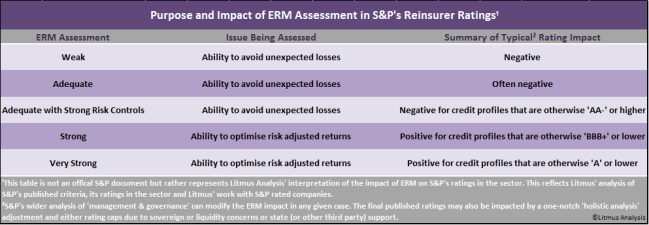With the backdrop of the approaching New Year and many insurance and reinsurance policies being renewed at 1.1., it seems that we will no doubt see the use of “ratings downgrade trigger clauses” reach another high.
The ability of individual re/insurance buyers to cancel a policy ab-initio following a downgrade from one or other of the main rating agencies might seem prudent but can become self-fulfilling and counter-productive. The problem is that whilst the act of cancelling the business is fairly harmless when it involves just two parties, there is a very real possibility that a herd mentality takes over; that is when the transition from a ‘BBB+’ ‘live’ insurer to a ‘BB’ or ‘BBB’ range run-off becomes more likely. So, while neither a ratings downgrade nor the loss of business make the insurer any less solvent than it already was, the market reaction to a downgrade can lead to the loss of business viability.
The market starts with ratings – a graded scale representing the notion of varying degrees of probability of failure to meet obligations (of an insurer paying claims) – a ‘staircase’ of differing levels, if you like, and turns that staircase into a cliff, then pushes the insurer over the cliff if it simply moves down one small step. How big is that step? A quick look at S&P’s detailed study of ratings performance (source http://bit.ly/1fDNqO0) tells us that the historical difference in the one-year default expectation of an ‘A-‘ rated entity compared to a ‘BBB+’ is less than 0.10%. That’s a pretty small step.
The other surprising thing about the insurance markets is that they generally ignore the ‘Outlook’ that is published by the rating agencies. We at Litmus have often asked whether it is better to deal with an ‘A-‘ with a negative outlook or a ‘BBB+/Positive’. Given S&P’s definition of an outlook (“Standard & Poor’s assigns positive or negative outlooks to issuer ratings when we believe that an event or trend has at least a one-in-three likelihood of resulting in a rating action over the intermediate term for investment-grade credits, generally up to two years” – source http://bit.ly/19xjqSV), it would seem that the ‘small step’ is even smaller in this case.
But the ratings cliff in the insurance industry of ‘A-‘ very often removes an insurer from the list of acceptable security from the lists of buyers and brokers alike, who collectively line up to push the insurer over the business viability cliff. They then leave themselves with a ‘legacy’ headache.
Much is made of the ‘power of the rating agencies’ by market commentators, but it’s not the agencies who distribute the business or make the decisions with regard to which re/insurer to use (or indeed how ratings are used) – it’s the buyer and/or the broker. The power lies with them with regard to the role that ratings play in the market, and the default position is perhaps down to human nature; protecting yourself against criticism should the re/insurer you choose fail.
At Litmus we make a big noise about the importance of understanding ratings and using them carefully for a reason – like any forecast or tool, understanding what lies behind it and using it sensibly is vital.
